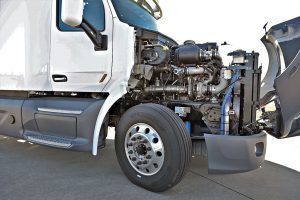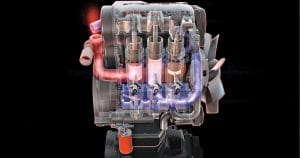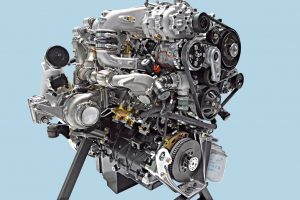An ultra-low emission two-stroke engine could prove that an IC engine is not exiting the scene in a hurry.
Its just another day in the Texas countryside. A nondescript Peter 579 Class-eight truck is cruising down the highway without arousing much suspicion. It is fitted with an opposed piston two-stroke ultra low emission engine that could well mean that the IC engine is not over yet. At a time when heavy-duty internal combustion is frequently castigated in the shadow of zero-emission all-electric and fuel-cell powertrains, a leading non-profit clean transportation group is lavishing praise on an oil burner that has shown the ability to meet the nation’s toughest emissions standards six years ahead of schedule. South California-based CALSTART with locations in Colorado, Florida, Michigan and New York, has developed a 10.6-litre opposed piston two-stroke engine from Achates Power for the cause. Hitting the road in a Walmart fleet truck, the engine is nothing short of a mechanical miracle. The Ultra-Low NOx Heavy-Duty Truck Demonstrator programme that this truck is a part of, is by the California Climate Investments. CALSTART is managing the project. Its work involves collecting and analyzing emissions and performance data in the Peterbilt 579 equipped with an innovative and cost-minded two-stroke that’s designed to replace 13- and 15-litre four-stoke diesels that may prove too pricey for some fleets to upgrade to meet 2027 emissions standards.
Results from dynos in San Diego and Detroit, along with a test mule 579 in Denton, Texas, have been highly encouraging. They point at a new lease of life for an internal combustion engine that is much cleaner; much cleaner for use in fleets consider, and more sustainable as a powertrain. During a recent online presentation focusing on the Achates 10.6-litre opposed piston two-stroke engine and its upcoming demo programme scheduled to take place in Southern California from July through September, CALSTART Executive Vice President Bill Van Amburg termed the engine as ‘the cleanest combustion, lowest carbon combustion engine in the world’. Though the tall 10.6-litre IC engine can achieve the California Air Resource’s Board ultra-low NOx standard of 0.02 grams per brake horsepower per hour and meet EPA’s 2027 CO2 requirement, Amburg pointed out that it was still viewed as a bridge to zero emissions. CALSTART is aiming at zero emissions and zero carbon, which is a long pathway. To get there, it is well-aware of needing all the tools in the tool chest. For the start, the heavy-duty opposed piston two-stroke engine on the Peterbilt 579 is showing much promise.

 Performing better than many thought it would, the engine, according to Achates Chief Technical Officer Fabien Redon, has scope for further reducing emissions. A leaner burning attribute inherent with engine design makes it ideal for gaseous fuel use such as renewable natural gas and hydrogen, he informed. An engine burning hydrogen without any after-treatment system requirement and without any actual emissions coming out of the tailpipe could truly define the future in regards to this powertrain it looks like. An interesting aspect of such an internal combustion engine burning hydrogen, according to Redon, is that it does not require a very high purity of hydrogen. Opening the doors for a low cost hydrogen use thus, this engine, it looks like, is set to open up very many new possibilities. Like the 10.6-litre engine on the Peterbilt 576, there’s a smaller 2.7-litre engine too that is also being subjected to evaluation. It is a candidate for gasoline compression ignition. With the demand for higher vehicle fuel efficiency around the globe rising, the 10.6-litre opposed piston two-stroke IC engine is showing good promise. It is holding up well in the wake of growing efforts at electrification.
Performing better than many thought it would, the engine, according to Achates Chief Technical Officer Fabien Redon, has scope for further reducing emissions. A leaner burning attribute inherent with engine design makes it ideal for gaseous fuel use such as renewable natural gas and hydrogen, he informed. An engine burning hydrogen without any after-treatment system requirement and without any actual emissions coming out of the tailpipe could truly define the future in regards to this powertrain it looks like. An interesting aspect of such an internal combustion engine burning hydrogen, according to Redon, is that it does not require a very high purity of hydrogen. Opening the doors for a low cost hydrogen use thus, this engine, it looks like, is set to open up very many new possibilities. Like the 10.6-litre engine on the Peterbilt 576, there’s a smaller 2.7-litre engine too that is also being subjected to evaluation. It is a candidate for gasoline compression ignition. With the demand for higher vehicle fuel efficiency around the globe rising, the 10.6-litre opposed piston two-stroke IC engine is showing good promise. It is holding up well in the wake of growing efforts at electrification.
Given the projections of IC engines going out of use, particularly for lower octane gas configurations, the new powertrain tech makes for a promising future. Especially in view of the fact that higher compression ratio engines are considered to be more fuel efficient albeit with the use of higher octane fuel. Said Achates Executive Vice President of Business Development Larry Fromm, “The ability to buy a low octane gasoline and get a huge cost savings.” While it is being projected that the ability to buy a low octane gasoline and incur huge cost savings is highly desirable and cost effective, the ability of the new opposed piston two-stroke IC engine to meet many complex requirements is looked at with much appreciation. As the thinking gathers pace regarding the future of carbon and how it is constrained, the new engine tech could prove to be the beginning of a new era. Against the thought that a full range of fuels and technologies will be needed to meet the climate change challenge, the new engine powertrain could well be the new beginning for IC engine technology. It is innovative and delivers important benefits in a smaller package, according to Fromm. Expressed an industry expert, that the Achates 10.6-litre diesel engine will go a long way in proving those wrong who questioned the future of IC engine. With some unconventional thinking, there’s plenty of innovation, efficiency gains and even lower emissions to be achieved in the case of an IC engine, he added.
Relegated to a distant backseat as emissions regulations tightened through the years and made the engines appear seemingly out of reach of any clean tech advancements, the Achates opposed piston two-stroke motor stands to draw inspiration from one of the longest flights powered by internal combustion engine – an opposed piston, two-stroke diesel unit. It was late James Lemke, physicist and internal combustion innovator, who thought the technology deserved another look and began R&D efforts with the support of late Walmart heir John Walton, who founded Achates Power in 2004. Seventeen years later, their dream seems to come true in the form of the motor powering the Peterbilt 579. The steady performance gains of the technology have not left many unimpressed, avers Fromm. He draws attention to the partnership inked with Saudi Aramco’s U.S.-based subsidiary Aramco Services Company in 2018 for the development of a series of opposed piston engines. One Achates 10.6-litre engine is being tested on an Aramco dyno in Detroit while another resides on an Achates’ dyno in San Diego. A Peterbilt 579 in Denton, Texas, has also served as a tester for a phase one 10.6-litre. Another 579 is set to roll-out in July for Walmart with an improved phase two engine.
The more recent results, which account for a seven-per cent reduction in CO2 and a 96 per cent reduction in NOx are highly encouraging. They are from the phase two engine with an upgraded air system. The phase two engine has air system improvements in the form of a SuperTurbo turbocharger and an Eaton EGR pump. Friction improvements are courtesy of Tenneco DuroGlide compression rings, Oerlikon Metco spray bore coating and 0W20 viscosity oil. Rated at 1674 lb. ft. of torque with room to grow, the second phase opposed piston two stroke 10.6-litre engine on the Walmart Peterbilt 579 develops 400 hp. Further improvement could elevate the horsepower even further. In terms of fuel efficiency, this engine is claimed to be seven-per cent better. Bolted to a conventional underfloor aftertreatment system with SCR, the engine, typical of a two-stroke IC engine is devoid of any valvetrain mechanism. It is less complex and incurs less raw material and production costs. Expected to cost about USD 10,000 less at the 2027 emissions level when compared to the solutions that the four-stroke engine will need to deploy to achieve that performance, according to Redon, the new opposed-piston IC engine has the big advantage of being less complex. With cost having a direct relation with complexity in the case of existing IC four-stroke engines that will transition to the new emission level, the new opposed piston two stroke engine is taking Achates Power, places. The company has teamed up with Cummins to produce and test a 14.3-litre tank engine. It is currently seeking additional partners to bring the 10.6-litre to production. The engine is expected to hit the market in time for the 2027 emissions regulations in the USA.





























